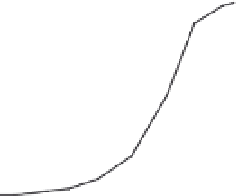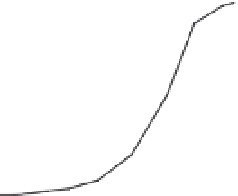Environmental Engineering Reference
In-Depth Information
thus differs from that observed in basalts, in which
the results are much the same regardless to particle
size fraction of material that is tested.
The compaction tests made with the azorean
samples exhibit values for the maximum dry density
between 12.1 and 14.1 kn/m
3
, for the optimum
water content values between 15 and 35%.
in the laboratory the mechanic resistance of
the basaltic pyroclasts was evaluated through
cBR tests, having obtained values that varied
between 42-73%. it was possible to verify that this
mechanic resistance is much better if the tested
granulometric fraction is finer.
on what regards the in situ tests, as it was
already mentioned, the presented results were
obtained in different tests executed in different
landfills, such as in situ dry density, determinated
in experimental landfills, and plate load tests
(PlT).
The values obtained for the in situ dry density in
landfills varied between 12.2 and 18.7 kn/m
3
, and
it was possible to verify that their value increases
with the decrease of the particle dimensions, show-
ing the opposite on what regards of water absorp-
tion (Fraga 2009).
nineteen plate load tests were performed with
0.3 and 0.6 m diameter plates, obtaining val-
ues that varied between 70 Pa and 140 Pa, for
the deformability secant modulus for a tension
of 300 kPa, and between 120 and 480 Pa in the
recharge (
Figure 4
).
Besides the tests performed in landfills, some
sPT tests were executed in natural deposits, and
n
sPT
values between 4 and 20 were obtained,
with a medium value of 12. These low values in
a rocky material show the loose and uncompact
state of these formations in nature due to their
genesis.
3.2
Comparison of test results
Figure 5 shows the results of the tests for parti-
cle size distribution of samples. The grading of
Madeira basaltic pyroclasts are presented with
a continuous line while the ones of the azorean
samples are presented with a hatched line.
according to the asTM D2487 standard, the
majority of Madeira samples are classified as sand
and those of the azores as gravel.
For a better comparison of the results obtained
in the tests for the determination of specific weight,
dry density, cBR, friction angle, and cohesion, a
are presented for the Madeira, azores and canarias
archipelagos.
on what regards the specific weights values, it is
possible to verify that the azorean samples are the
ones that presents lower values followed by those
of canarias, being the ones from Madeira, those
with higher specific weights.
on what concerns the results obtained for the in
situ dry density, it is possible to verify that there is a
range of values common to Madeira and canarias
archipelagos, though canarias presents a wider
range. The values of maximum dry density found
in the azorean pyroclasts are lower than to those
obtained in the laboratory for the Madeira pyro-
clasts as observed for the specific weight.
Data related to cBR tests, friction angle and
cohesion are similar in the existing samples. how-
ever, it's possible to verify the existence of higher
cBR values for Madeira samples.
Regarding the results obtained in the plate load
tests, it is possible to see that with the azorean
pyroclasts the dispersion of value is smaller than
the Madeira ones, which is expectable, once the
values refer to compacted landfills and in Madeira
samples, the values refer to natural deposits with
different degrees of compaction.
400
350
clay-silt
sand
gravel
C
0
100
300
10
20
30
40
50
60
70
80
90
100
90
250
80
70
200
60
50
150
40
30
100
20
50
10
0
0
mm
0,0
0,5
1,0
1,5
2,0
2,5
Deflection (mm)
Figure 5. comparison of the particle size distribution
curves obtained on Madeira and azores pyroclastic
rocks.
Figure 4. Typical plate load test curves obtained on
landfills made with basaltic pyroclastic rocks.




















































































































































































































































































































































































































